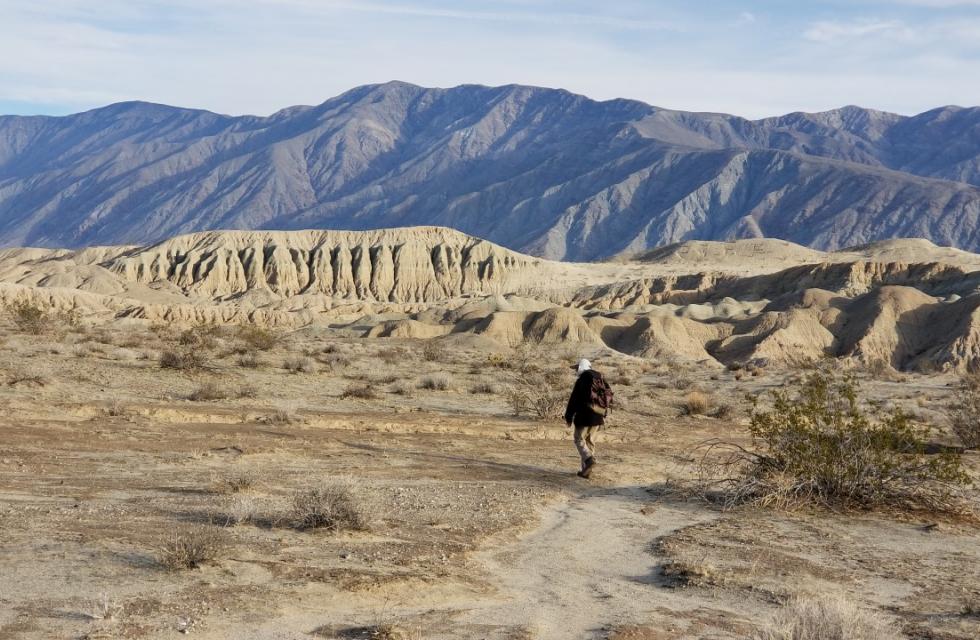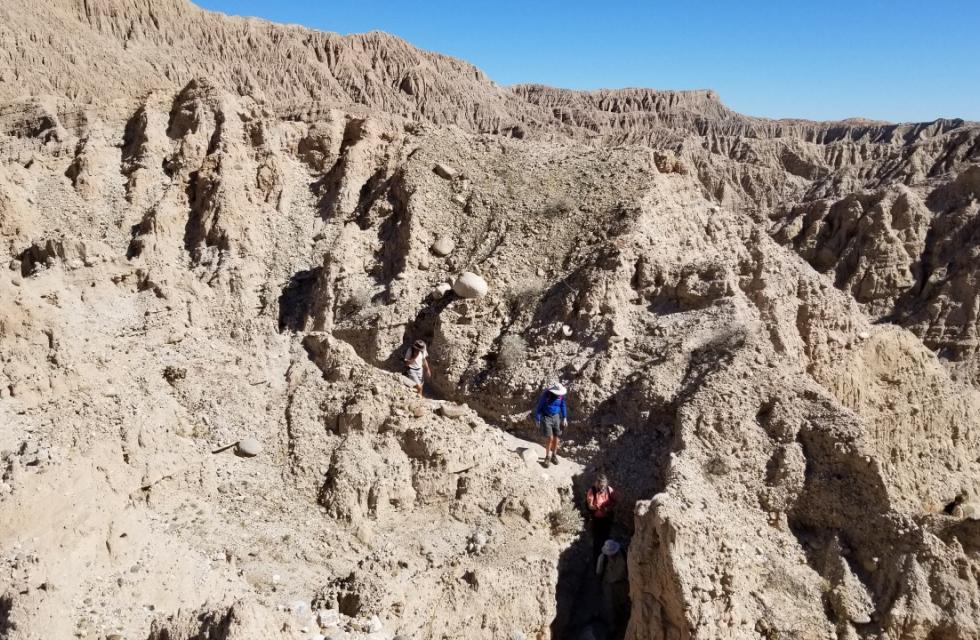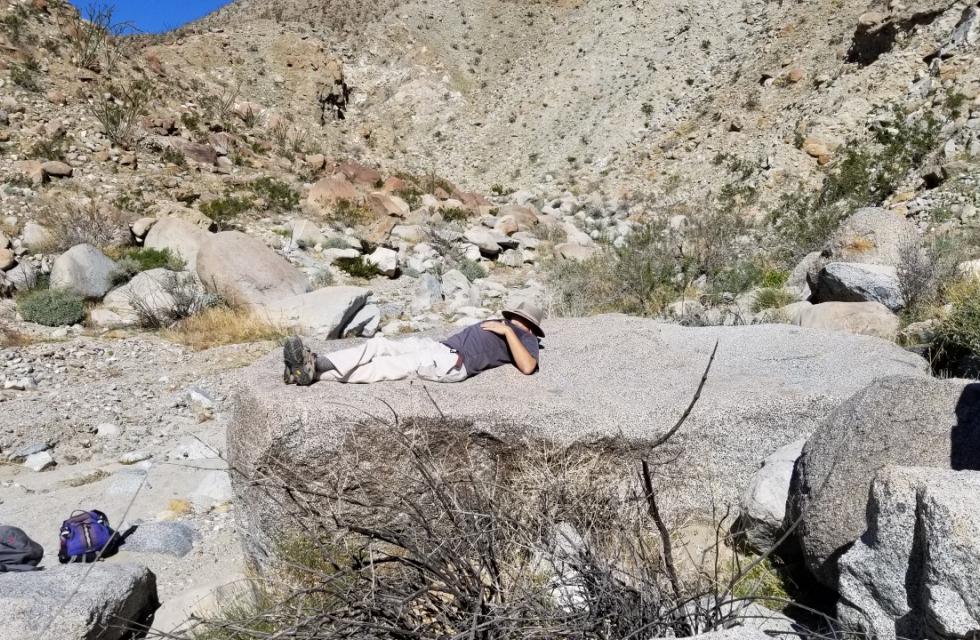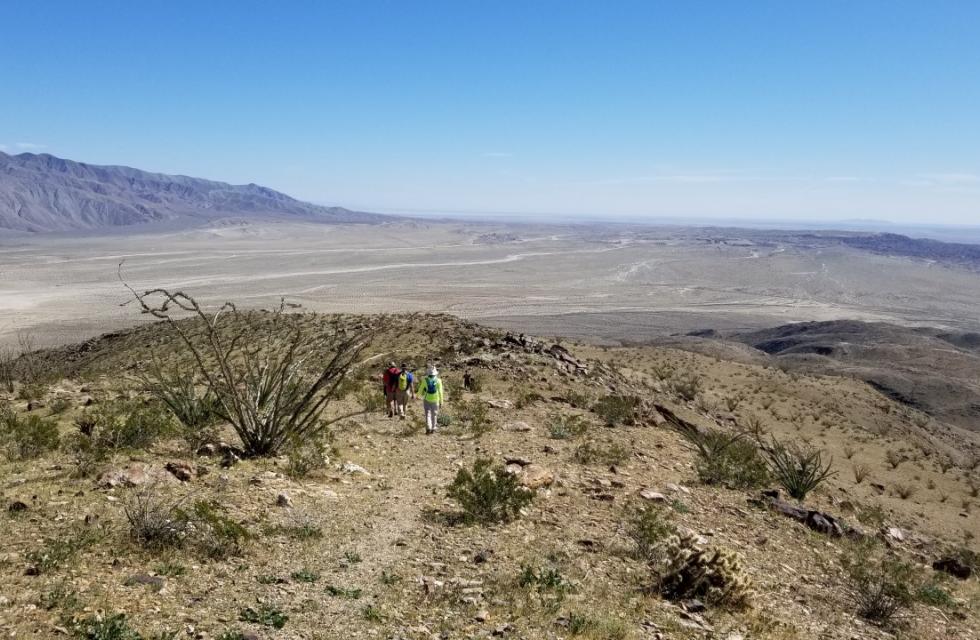Learning to Walk in Nature
Learning to Walk in Nature
Sanjiv Nanda
In the desert, a two-hour drive east of San Diego lies the sleepy little community of Borrego Springs. If you have never been here, or have never heard of it – think of Palm Springs or Phoenix and set the clock back fifty years. Shrink the population density fifty-fold. Remove the upscale resorts and hotels, malls and office parks, restaurants and condos, and replace them with the 600,000 acres of open space that is the Anza-Borrego Desert State Park. In Borrego, Nature sits at your doorstep and beckons. Fortunate are those who hear its call and learn to walk in Nature.
The population of Borrego Springs grows in winter due to the annual migration of snowbirds that head south from Oregon and Washington and British Columbia as well as places further east such as Wisconsin, New Hampshire and Maine. The ones who escape the lures and traps set up by the developers north of the Santa Rosas and make their way south to Borrego Springs find that on the south side, the air is cleaner, the light is brighter, the winter sun, warmer. What Borrego Springs lacks in urban attractions, it makes up for in open spaces, badlands landscapes, sandstone canyons and dry waterfalls. Instead of exploring malls, residents in Borrego explore washes and dry river beds in search of plant life. Instead of pursuing marked-down designer clothing, residents join state park paleontology experts on backcountry explorations in search of fossils. Instead of spotting film stars and celebrities at restaurants and golf courses, residents hike up the Borrego Palm Canyon and other known wet spots in hopes of spotting Borrego, the desert bighorn sheep.
In Borrego, expert and amateur paleontologists and archaeologists, botanists and birders, rub shoulders with geologists and astronomers, something that rarely happens even at our top universities. Residents find real-world field work experience in these empirical sciences. They develop an eye for distinguishing anticlines from folds, conglomerates from Sturzstrum, observing the movement of tectonic plates, seeing the results of erosion from water and wind. On a hike with locals, you might hear a scream because someone spotted the first desert lily bloom of the season or a ghostflower in bloom in a previously unknown location. Or as it happened on a hike in the badlands a couple of years ago, when someone in our group shouted an expletive – barely exposed in the sandstone was a several-foot section of a mammoth tusk!
To experience such thrills, Borregans spend lots of time outdoors. They attend classes and lectures to prepare for what to observe in the field. Then they go on hikes and field trips with both local and invited experts to develop their field observation skills, learning to see and hear. Some of this occurs formally on organized field trips. Yet, a lot more occurs informally, on every outing in Borrego as participants readily share their knowledge and experience. Thus, on a geology trip, in addition to learning about plate tectonics and the San Andreas fault, someone in the group will take the time to point out the difference between sand verbena and trailing windmills. Equally, on a wildflower walk, while learning to recognize the numerous members of the pea family that call the desert home, Borregans also learn about the difference between mica and quartz.
And so they walk. On organized and informal trips into the desert, Borregans walk. They listen, they look, and, then they walk some more. Looking for plants and rocks, they follow desert washes that turn into slot canyons, they climb up dry waterfalls, and when the trail vanishes, they scramble up crumbly ridges. To my friend Bill Sullivan, “a trail is like a prison cell. You are forced to remain where the trail-builders want you to remain. Your views are restricted to what you can see from the trail. This is ok, maybe even fine, in dense vegetation like a chaparral or a forest, or on the steep sides of a mountain. In a desert, you can walk off a trail. You have freedom. If you see something to admire or look at from up close, like a tree or an outcrop or animal tracks, you can do it. I love the freedom.”
Even in the wide-open desert there are trails that were created by nature, by the action of water that flowed during the infrequent rainstorms that have occurred over millennia. Often these dry desert washes are easy to follow upstream as it were, although there is no stream of water. Slowly proceeding up the wash, imperceptibly, the canyon walls rise. More and newer plants start to appear, some in bloom, depending on the season, the altitude, and the location. Plant life provides sustenance to a more varied fauna. Little reptiles skitter past hither and thither. A jackrabbit hiding for the longest time behind a bush finally decides to take off in leaps and bounds across rocks and cactus, then bounds up the canyon wall. In these desert canyons, as on any trail, there is always the desire to explore beyond the next turn, and then the next one after that. Often there is no destination on these desert walks, only the desire to experience the solitude, to observe that the desert is alive.
In the barren desert, the geology is exposed for you to see. The spare flora and the sparse fauna beckon you to notice. New visitors to the desert are often disappointed, they see vast, unending nothingness. Veteran eyes find that there is so much more to see. Each rock and outcrop tells an ancient story going back millennia, tracks in the desert share what happened earlier today or even earlier this week, sometimes earlier this season. I have seen mouse tracks leading to nests protected by cholla, sidewinder tracks moving from sun to shade. I have seen coyote tracks and bird feathers that told an unhappy tale.
Then there is the light. As the sun moves every day from east to west, and over the seasons from north to south and then back again, the light changes. The early morning and evening light of the winter sun puts on a show – a dance of the light and shadows on the mud hills, on the granite and sandstone folds. No tickets are required. Just cancel your subscription to cable television, put down your smartphone and step outside.
So Borregans step outside, and walk. In winter they walk on the desert floor. They walk in the washes, canyons and alluvial fans, they walk up dry waterfalls. As the weather warms, they move higher. They walk in shady canyons, they walk in the mountains to the west. While day-trippers from the city go on hikes, Borregans walk. As Bill Sullivan says, “I don’t hike. I walk.” When you hike, you have goals, miles to travel, destinations to get to, peaks to bag. When you hike, you see the desert as nothingness. When you walk, you really see.
The young have a long life ahead and yet they are always in a hurry to go places, so they hike. There is a minimum age to walk. According to Thoreau, “if you have paid your debts, and made your will, and settled all your affairs, and are a free man – then you are ready for a walk.” Thoreau refers to walking as a noble art. “No wealth can buy the requisite leisure, freedom and independence which are the capital in this profession.” Borregans are truly endowed with riches.



